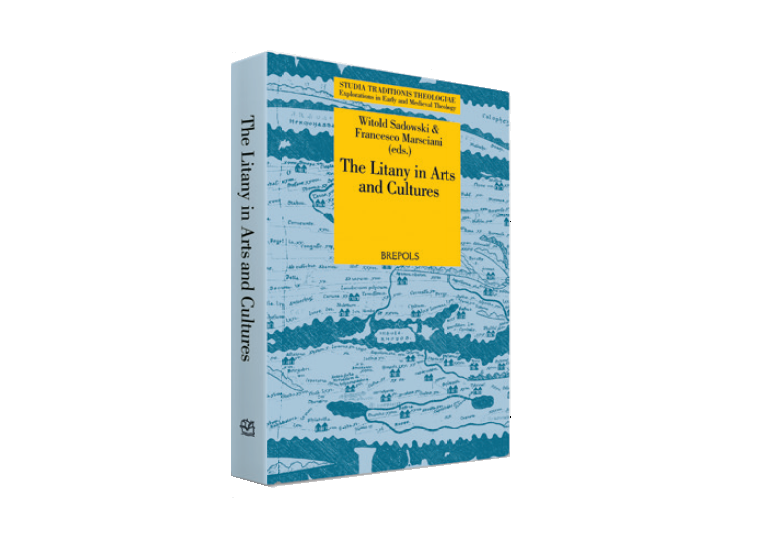Article – The semiotics of litanies from the Middle Ages to the YouTube era (2020)
NeMoSanctI members Jenny Ponzo, Francesco Galofaro and Gabriele Marino are proud to be part of this beautiful publication from Brill dedicated to the subject of the litany: The Litany in Arts and Cultures, edited by fellow literary scholar Witold Sadowski and fellow semiotician Francesco Marsciani, scheduled to appear in April 2020.
More info can be found on the publisher’s website.
The article by Ponzo, Galofaro and Marino, which closes the collection, is entitled: “The semiotics of litanies from the Middle Ages to the YouTube era: Interpretative, intersemiotic, and performative issues“.

The Litany in Arts and Cultures
W. Sadowski, F. Marsciani (eds.)
ISBN: 978-2-503-58670-0The book encompasses a broad historical panorama and considers the presence of litanic prayers and songs in different religions, beginning with written records in the Egyptian, Sumerian and Hebrew languages and finishing with Christian works of diverse denominations.
The articles in this book encompass a broad historical panorama and consider the presence of litanic prayers and songs in different religions, beginning with written records in the Egyptian, Sumerian and Hebrew languages and finishing with Christian works from diverse denominations. The research presents the litany as an exceptionally long-lasting genre which for several thousand years existed in the Middle-Eastern and European traditions, easily conforming to changes in religious or historical circumstances. An interdisciplinary approach by scholars representing different fields of study, including the history of liturgy, Egyptology, Assyriology, literary studies, musicology and ethnosemiotics, allows the eclectic character of litanies to be revealed, litanies which not only were a form of church prayer but also had an impact on the organization of social rituals as well as being appropriated by all the major fields of art, poetry, the fine arts and music. The musicological articles in the book address the performance of Sumerian prayers, the liturgical songs of the Middle Ages, litanies in Tudor England and polyphonic works of the great composers, such as Wolfgang Amadeus Mozart.
Witold Sadowski is professor of literary theory at the University of Warsaw. His latest book European Litanic Verse: A Different Space-Time (2018) describes enumerative versification from Antiquity to Early Modernity with a particular focus on the space-time matrix within which the world is depicted in litanic poems.
Francesco Marsciani is professor of semiotics and ethnosemiotics at the University of Bologna. He was a student of Umberto Eco in Bologna and Algirdas Greimas in Paris. Among his publications are the following books: Ricerche Semiotiche I and II, and Tracciati di Etnosemiotica (recently translated into French).
Table of Contents
– Witold Sadowski (University of Warsaw, Poland), Magdalena Kowalska (Nicolaus Copernicus University in Toruń, Poland), Magdalena Maria Kubas (University of Warsaw, Poland), Studies on Litanies in the Past and Present
– Roland Enmarch (University of Liverpool, UK), Litanies in Ancient Egyptian Written Culture
– Uri Gabbay (Hebrew University of Jerusalem, Israel), Litanies in the Sumerian Liturgy of Ancient Mesopotamia: A Typology of a 2,000-Year-Long Transmission History
– Sam Mirelman (SOAS University of London, UK), Performative Aspects of Litanies in Sumerian Liturgical Prayers, According to Selected Late Manuscripts
– Christos G. Karagiannis (University of Athens, Greece), Aspects of Litany in the Old Testament
– Marie-Emmanuelle Torres (Aix Marseille University, CNRS, LA3M, Aix-en-Provence, France), ‘Πολλὰ ἔτη εἰς πολλά’: Some Litanic Practices in Byzantine Imperial Ceremonies?
– Bernard Sawicki OSB (Pontifical Atheaneum of St. Anselm in Rome, Italy), A Litany in the Rule of St. Benedict
– Mary Channen Caldwell (University of Pennsylvania, USA), Litanic Songs for the Virgin: Rhetoric, Repetition, and Marian Refrains in Medieval Latin Song
– Joris Geldhof (Catholic University of Leuven, Belgium), The Litany of Saints of the Easter Vigil in the Roman Rite
– Magnus Williamson (Newcastle University, UK), Singing the Litany in Tudor England, 1544–1555
– Karina Zybina (Paris Londron University of Salzburg, Austria), When Music Takes Over: Sacramental Litanies in the European Music History
– Tiziana Palandrani, Sardinia’s Funerary Lamentations – The Attitos, A Case of Litany?
– Jenny Ponzo (University of Turin, Italy), Francesco Galofaro (University of Turin, CUBE, Bologna, Italy), and Gabriele Marino (University of Turin, Italy), The semiotics of litanies from the Middle Ages to the YouTube era: Interpretative, intersemiotic, and performative issues

